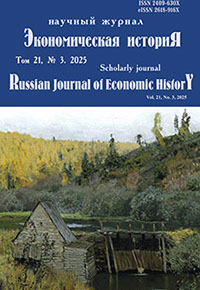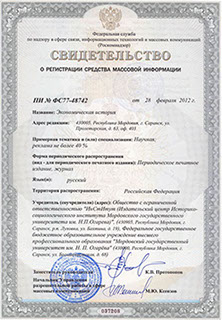Экономическая историЯ
Russian Journal of Economic History
ISSN 2409-630X (Print)
ISSN 2618-916X (Online)
Expert board:
- Scientific Council of RAS on economic history;
- Research and Educational Center «The economic history of Central Russia and the Middle Volga region» of Ogarev Mordovia State University;
- Center of Economic History of Lomonosov Moscow State University
Navigation
ISSN 2409-630X (Print), ISSN 2618-916X (Online)
DOI: 10.24412/2409-630X.070.021.202503.283-290
УДК 614.449(47)’’18/19’’
Elena S. Kravtsova1, Pavel N. Alyoshin2
1 Kursk State Medical University (Kursk, Russia),
e-mail: elenakravcova@yandex.ru
2 Sterlitamak branch of the Federal State Budget Educational Institution of Higher Education “Bashkir State University” (Sterlitamak, Russia),
e-mail: p.n.aleshin@struust.ru
Organization of Russian zemstvos’ control of gophers in the late 19th and early 20th centuries
Abstract
Introduction. In the late 19th and early 20th centuries, Russia was engaged in the control of gophers as agricultural pests and disease vectors. However, there was no clear plan for controlling gophers at that time, and measures were implemented differently in different regions. The purpose of this article is to study the effectiveness of control measures for these small rodents in Russia in the late 19th and early 20th centuries.
Materials and Methods. This study utilizes published and unpublished sources on the organization of gopher eradication efforts. Therefore, primary source analysis is the most commonly used method, as it allows for the identification of various approaches to solving the problem. A comparative method allows for the assessment of the success of a given program for reducing gopher numbers in a given province. A statistical method allows for the calculation of the economic effectiveness of the decisions made. A thematic analysis method allows for the study of specific topics, such as the biological characteristics of a species, its habitat, and its diet, providing a more complete picture of the problem. These methods provide a solid foundation for studying the economic characteristics of farmers’ lives and assessing the scale of the disaster caused by the presence of gophers.
Results. Initially, gopher control was not regulated by any institutions and was rather the initiative of farmers themselves. However, beginning in the 1880s, methods of gopher control were subject to nationwide discussion, and zemstvos systematically organized the work, approaching the issue from a scientific perspective, involving specialists, and utilizing scientific discoveries. For example, in 1894, the Astrakhan Province developed “Instructions for the Extermination of Gophers”. It obligated rural communities, private owners, tenants, Cossacks, Kalmyks, and Kyrgyz to exterminate gophers on their lands through a labor service. For each locality, a mandatory gopher extermination rate was established, calculated per dessiatine. In the Don region, “Instructions for the Extermination of Gophers” were developed in 1913. It specified that gophers were to be exterminated on all land categories, including railroad rights-of-way, privately owned land, oatmeal fields, pastures, camp sites, and forests. The methods used by the population varied, from dousing the gophers with water and filling their burrows with earth to using toxic substances (such as carbon dioxide). These measures were mostly financed by local governments. Overall, the extermination of tens of thousands of gophers did not significantly improve the food supply in pre-revolutionary Russia.
Discussion and Conclusion. The provisions and conclusions presented in this article provide the basis for a more detailed study of the struggle of Russian zemstvos and farmers against various animals and insects harmful to agriculture in Russia in the late 19th and early 20th centuries and can also be used in teaching the subject of History of the Fatherland in universities and schools.
Keywords: gophers, Russian Empire, peasant farming, allotments, peasant commune, carbon sulfide.
For citation: Kravtsova E. S., Alyoshin P. N. Organization of Russian zemstvos’ control of gophers in the late 19th and early 20th centuries. Ekonomicheskaya istoriya = Russian Journal of Economic History. 2025; 21(3): 283–290. (In Russ.). DOI: 10.24412/2409-630X.070.021.202503.283-290.
© Ogarev Mordovia State University. History and Sociology Institute, 2017
68, Of. 411, Bolshevistskaya St., 430005, The editorial office of the scholarly journal «Russian Journal of Economic History»
Tel.: (8342) 24-25-90; 27-07-11, Fax: (8342) 24-25-90, E-mail: jurnal-econom-hist@isi.mrsu.ru
Designed by A. Napalkov, Email: napalkov@isi.mrsu.ru


